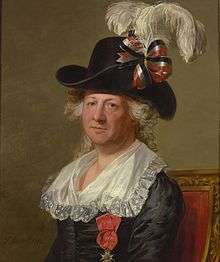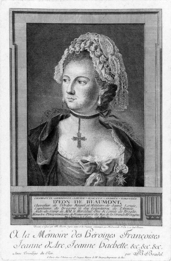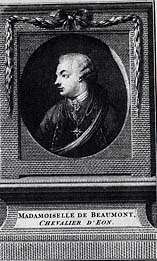Chevalier d'Eon
Due to the unique circumstances of d'Éon's life, this article avoids the use of gendered pronouns by repeating the name instead (see talk page).



Charles-Geneviève-Louis-Auguste-André-Timothée d'Éon de Beaumont (5 October 1728 – 21 May 1810), usually known as the Chevalier d'Éon, was a French diplomat, spy, freemason[1] and soldier who fought in the Seven Years' War. D'Éon had androgynous physical characteristics and natural abilities as a mimic, good features for a spy. D'Éon appeared publicly as a man and pursued masculine occupations for 49 years, although during that time d'Éon successfully infiltrated the court of Empress Elizabeth of Russia by presenting as a woman. For 33 years, from 1777, d'Éon dressed as a woman, claiming to have been female at birth. Doctors who examined d'Éon's body after d'Éon's death discovered that d'Éon would have actually been designated male at birth.
Early life
D'Éon was born at the Hôtel d'Uzès in Tonnerre, Burgundy, into a poor noble family. D'Éon's father, Louis d'Éon de Beaumont, was an attorney and director of the king's dominions, later mayor of Tonnerre and sub-delegate of the intendant of the généralité of Paris.[2] D'Éon's mother, Françoise de Charanton, was the daughter of a Commissioner General to the armies of the wars of Spain and Italy. Most of what is known about d'Éon's early life comes from a partly ghost-written autobiography, The Interests of the Chevalier d'Éon de Beaumont.[3]
D'Éon excelled in school, moving from Tonnerre to Paris in 1743, graduating in civil law and canon law from the Collège Mazarin in 1749 at age 21. D'Éon became secretary to Bertier de Sauvigny, intendant of Paris, served as a secretary to the administrator of the fiscal department, and was appointed a royal censor for history and literature by Malesherbes in 1758.[3]
Life as a spy
In 1756, d'Éon joined the secret network of spies called the Secret du Roi, employed by King Louis XV without the knowledge of the government. It sometimes promoted policies that contradicted official policies and treaties. According to d'Éon's memoirs (although there is no documentary evidence to support that account) the monarch sent d'Éon with the Chevalier Douglas, Alexandre-Pierre de Mackensie-Douglas, baron de Kildin, a Scottish Jacobite in French service, on a secret mission to Russia in order to meet Empress Elizabeth and conspire with the pro-French faction against the Habsburg monarchy. At that time the English and French were at odds, and the English were attempting to deny the French access to the Empress by allowing only women and children to cross the border into Russia. D'Éon had to pass convincingly as a woman or risk being executed by the English upon discovery. In the course of this mission, d'Éon was disguised as the lady Lea de Beaumont, and served as a maid of honour to the Empress. Eventually, Chevalier Douglas became French ambassador to Russia, and d'Éon was secretary to the embassy in Saint Petersburg from 1756 to 1760, serving Douglas and his successor, the marquis de l'Hôpital.[4] D'Éon's career in Russia is the subject of one of Valentin Pikul's novels, Le chevalier d'Éon et la guerre de Sept ans («Пером и шпагой»).
D'Éon returned to France in October 1760, and was granted a pension of 2,000 livres as reward for service in Russia. In May 1761, d'Éon became a captain of dragoons under the maréchal de Broglie and fought in the later stages of the Seven Years' War. D'Éon served at the Battle of Villinghausen in July 1761, and was wounded at Ulstrop. After Empress Elizabeth died in January 1762, d'Éon was considered for further service in Russia, but instead was appointed secretary to the duc de Nivernais, awarded 1,000 livres, and sent to London to draft the peace treaty that formally ended the Seven Years' War. The treaty was signed in Paris on 10 February 1763, and d'Éon was awarded a further 6,000 livres, and received the Order of Saint-Louis on 30 March 1763, becoming the Chevalier d'Éon.[4] The title chevalier, French for knight, is also sometimes used for French noblemen.
Back in London, d'Éon became chargé d'affaires in April 1763, and then plenipotentiary minister - essentially interim ambassador - when the duc de Nivernais returned to Paris in July. D'Éon used this position also to spy for the king. D'Éon collected information for a potential invasion - an unfortunate and clumsy initiative of Louis XV, of which Louis's own ministers were unaware - assisting a French agent, Louis François Carlet de la Rozière, who was surveying the British coastal defences. D'Éon formed connections with English nobility by sending them the produce of d'Éon's vineyard in France and abundantly enjoyed the splendour of this interim embassy.[4]
Upon the arrival of the new ambassador, the comte de Guerchy in October 1763, d'Éon was demoted to the rank of secretary and humiliated by the count. D'Éon was trapped between two French factions: Guerchy was a supporter of the duc de Choiseul, duc de Praslin and Madame de Pompadour, in opposition to the comte de Broglie and his brother the maréchal de Broglie. D'Éon complained, and eventually decided to disobey orders to return to France. In a letter to the king, d'Éon claimed that the new ambassador had tried to drug d'Éon at a dinner at the ambassador's residence in Monmouth House in Soho Square. The British government declined a French request to extradite d'Éon, and the 2,000 livres pension that had been granted in 1760 was stopped in February 1764. In an effort to save d'Éon's station in London, d'Éon published much of the secret diplomatic correspondence about d'Éon's recall under the title Lettres, mémoires et négociations particulières du chevalier d'Éon in March 1764, disavowing Guerchy and calling him unfit for his job.[5] This breach of diplomatic discretion was scandalous to the point of being unheard of, but d'Éon had not yet published everything (the King's secret invasion documents and those relative to the Secret du Roi were kept back as "insurance"), and the French government became very cautious in its dealings with d'Éon, even when d'Éon sued Guerchy for attempted murder. With the invasion documents in hand, d'Éon held the king in check.[6] D'Éon did not offer any defense when Guerchy sued for libel, and d'Éon was declared an outlaw and went into hiding. However, d'Éon secured the sympathy of the British public: the mob jeered Guerchy in public, and threw stones at his residence. D'Éon then wrote a book on public administration, Les loisirs du Chevalier d'Éon, which was published in thirteen volumes in Amsterdam in 1774.[7]
Guerchy was recalled to France, and in July 1766 Louis XV granted d'Éon a pension (possibly a pay-off for d'Éon's silence) and a 12,000-livre annuity, but refused a demand for over 100,000 livres to clear d'Éon's extensive debts. D'Éon continued to work as a spy, but lived in political exile in London. D'Éon's possession of the king's secret letters provided protection against further actions, but d'Éon could not return to France.[6]
Life as a woman



Despite the fact that d'Éon habitually wore a dragoon's uniform, rumours circulated in London that d'Éon was actually a woman. A betting pool was started on the London Stock Exchange about d'Éon's true sex. D'Éon was invited to join, but declined, saying that an examination would be dishonouring, whatever the result. After a year without progress, the wager was abandoned. Following the death of Louis XV in 1774, the secret du roi was abolished, and d'Éon tried to negotiate a return from exile. The writer Pierre de Beaumarchais represented the French government in the negotiations. The resulting twenty-page treaty permitted d'Éon to return to France and retain the ministerial pension, but required that d'Éon turn over the correspondence regarding the secret du roi.[6]
The Chevalier d'Éon claimed to have been assigned female at birth, and demanded recognition by the government as such. D'Éon claimed to have been raised as a boy because Louis d'Éon de Beaumont could only inherit from his in-laws if he had a son. King Louis XVI and his court complied with this demand, but required in turn that d'Éon dress appropriately in women's clothing, although d'Éon was allowed to continue to wear the insignia of the Order of Saint-Louis. When the king's offer included funds for a new wardrobe of women's clothes, d'Éon agreed. In 1777, after fourteen months of negotiation, d'Éon returned to France and as punishment was banished to Tonnerre.[6]
When France began to help the rebels during the American War of Independence, d'Éon asked to join the French troops in America, but d'Éon's banishment prevented it.[6] In 1779, d'Éon published a books of memoirs: La Vie Militaire, politique, et privée de Mademoiselle d'Éon. They were ghostwritten by a friend named La Fortelle and are probably embellished.[4] D'Éon was allowed to return to England in 1785.
The pension that Louis XV had granted was ended by the French Revolution, and d'Éon had to sell personal possessions, including books, jewellery and plate. The family's properties in Tonnerre were confiscated by the revolutionary government. In 1792, d'Éon sent a letter to the French National Assembly offering to lead a division of female soldiers against the Habsburgs, but the offer was rebuffed. D'Éon participated in fencing tournaments until seriously wounded in Southampton in 1796. D'Éon's last years were spent with a widow, Mrs. Cole.[6] In 1804, d'Éon was sent to a debtors' prison for five months, and signed a contract for a biography to be written by Thomas William Plummer, which was never published. D'Éon became paralyzed following a fall, and spent a final four years bedridden, dying in poverty in London on 21 May 1810 at the age of 81.[6]
Doctors who examined the body after d'Éon's death discovered that the Chevalier had "male organs in every respect perfectly formed", while at the same time displaying feminine characteristics such as rounded limbs and "breast remarkably full".[8] D'Éon's body was buried in the churchyard of St Pancras Old Church, and d'Éon's remaining possessions were sold by Christie's in 1813. D'Éon's grave is listed on Baroness Burdett Coutts's memorial there as one of the important graves lost.
Legacy
- Havelock Ellis coined the term eonism to describe similar cases of transgender behavior; it is rarely used now.[4]
- The Chevalière d'Eon, by Charles Dupeuty and the Baron de Maldigny (1837), Théâtre du Vaudeville[9]
- The Chevalier d'Eon, a comedy in 3 acts by Dumanoir and Jean-François Bayard (1837), Théâtre des Variétés[10]
- The Beaumont Society, a long-standing organisation for transgender people, is named after the Chevalier d'Éon.
- Spy of Madame Pompadour (1928), film.
- Le secret du Chevalier d'Éon (1959), a film loosely based on the life of the Chevalier that portrays d'Éon as a woman masquerading as a man.
- Le Chevallier D'eon, a series of manga written by Tou Ubukata and illustrated by Kiriko Yumeji; it is published by Del Rey Manga
- Le Chevalier d'Eon (2006), an anime series loosely based on the Chevalier d'Éon.
- Eonnagata, a 2010 theatre piece by Canadian Robert Lepage, combining drama and dance, based on the life of the Chevalier d'Éon.
- Some of d'Éon's papers are at the Brotherton Library in Leeds, U.K.[4]
- In 2012, a painting owned by the Philip Mould Gallery was identified as a portrait of d'Éon[11] and purchased by the National Portrait Gallery, London.[12]
- Appeared as one of the summonable servants in mobile game Fate/Grand Order.
References
- ↑ Initiated at London's Immortality Lodge number 376 in 1768 and later member of Les Amis réunis lodge in Tonnerre (in Le Chevalier d'Eon, franc-maçon et espionne - Daniel Tougne - Trajectoires ed. 2012)
- ↑ J. M. J. Rogister, D'Éon de Beaumont, Charles Geneviève Louis Auguste André Timothée, Chevalier D'Éon in the French nobility (1728–1810), Oxford Dictionary of National Biography, Oxford University Press, 2004; online edn, Sept 2012 accessed 26 April 2013
- 1 2 Lever, Evelyne; Maurice Lever (19 February 2009). Le Chevalier d'Éon : Une vie sans queue ni tête. Fayard. pp. 384 pages. ISBN 978-2-213-61630-8.
- 1 2 3 4 5 6 Burrows, Simon; Russell Goulbourne; Jonathan Conlin; Valerie Mainz (23 April 2010). The Chevalier d'Éon and his worlds: gender, espionage and politics in the eighteenth century. Continuum. pp. 272 pages.
- ↑ Lettres, mémoires et négociations particulières du Chevalier D'Éon, ministre plénipotentiaire auprès du roi de Grande-Bretagne; avec M.M. les Ducs de Praslin, de Nivernois, de Sainte-Foy, & Regnier de Guerchy, Ambassad. Extr. &c.&c.&c. (1765)
- 1 2 3 4 5 6 7 Burrows, Simon (October 2006). Blackmail, scandal and revolution London's French libellistes, 1758–92. Manchester, UK: Manchester University Press. 9780719065262.
- ↑
 Chisholm, Hugh, ed. (1911). "Eon de Beaumont". Encyclopædia Britannica 9 (11th ed.). Cambridge University Press.
Chisholm, Hugh, ed. (1911). "Eon de Beaumont". Encyclopædia Britannica 9 (11th ed.). Cambridge University Press. - ↑
 Laughton, John Knox (1888). "D'Éon de Beaumont, Charles Geneviève Louis Auguste André Timothée". In Stephen, Leslie. Dictionary of National Biography 14. London: Smith, Elder & Co.
Laughton, John Knox (1888). "D'Éon de Beaumont, Charles Geneviève Louis Auguste André Timothée". In Stephen, Leslie. Dictionary of National Biography 14. London: Smith, Elder & Co. - ↑ The Chevalier d'Eon and Other Short Farces from the Eighteenth and Nineteenth Century French Theatre, By Frank J. Morlock
- ↑ Theatrical Costume, Masks, Make-up and Wigs: A Bibliography and Iconography, by Sidney Jackson Jowers, p. 314
- ↑ Bryner, Jeanna (19 April 2012). "Earliest Painting of Transvestite Uncovered". Live Science. Retrieved 20 April 2012.
- ↑ Brown, Mark (6 June 2012). "Portrait mistaken for 18th-century lady is early painting of transvestite". The Guardian (UK). Retrieved 22 September 2014.
Further reading
- Decker, Michel de. Madame Le Chevalier d'Éon, Paris: Perrin, 1987, ISBN 978-2-7242-3612-5.
- d'Éon De Beaumont, Charles. The Maiden of Tonnerre: The Vicissitudes of the Chevalier and the Chevalière d'Éon, Baltimore, MD: Johns Hopkins University Press, 2001, ISBN 978-0-8018-6687-6.
- d'Éon, Leonard J. The Cavalier, New York: G.P. Putnam's Sons, 1987, ISBN 0-399-13227-9.
- Frank, André, with Jean Chaumely. D'Éon chevalier et chevalière: sa confession inédite, Paris: Amiot-Dumont, 1953.
- Fortelle M. de la. La Vie militaire, politique et privée de Demoiselle Charles-Geneviève-Auguste-Andrée-Thimothée Éon ou d'Èon de Beaumont, [... etc.], Paris: Lambert, 1779.
- Gaillardet, F. (ed.), Mémoires du chevalier d'Éon, Paris, 1836, 2 vols.
- Gontier, Fernande. Homme ou femme? La confusion des sexes, Paris: Perrin, 2006, Chapter 6. ISBN 978-2262024918.
- Homberg, O., and F. Jousselin, Un Aventurier au XVIIIe siècle: Le Chevalier D'Éon (1728-1810), Paris: Plon-Nourrit, 1904.
- Kates, Gary. Monsieur d'Éon Is a Woman: A Tale of Political Intrigue and Sexual Masquerade, Baltimore, MD: Johns Hopkins University Press, 2001, ISBN 978-0-8018-6731-6.
- Lever, Évelyne and Maurice. Le Chevalier d'Éon: Une vie sans queue ni tête, Paris: Fayard, 2009, ISBN 978-2-213-61630-8.
- Luyt, Philippe. D'Éon de Tonnerre. Iconographie et histoire, 2007, OCLC 163617123
- Mourousy, Paul. Le Chevalier d'Éon: un travesti malgré lui, Paris: Le Rocher, 1998, ISBN 978-2-268-02917-7.
- Musée municipal de Tonnerre, Catalogue bilingue de l'exposition, Le Chevalier d'Éon: secrets et lumières, 2007.
- Royer, Jean-Michel. Le Double Je, ou les Mémoires du chevalier d'Éon, Paris: Grasset & Fasquelle, 1986, ISBN 978-2-246-38001-6.
- Telfer, John Buchan, The strange career of the Chevalier d'Eon de Beaumont, minister plenipotentiary from France to Great Britain in 1763, 1885, OCLC 2745013
External links
| Wikimedia Commons has media related to Chevalier d'Éon. |
- British Museum, Le Chevalier d'Eon, 1764, portrait
- British Museum, Mademoiselle La Chevaliere D'Eon de Beaumont, portrait
- British Museum, George Dance, Chevalier D'Eon, Graphite with watercolour, bodycolour and red stump, England, 1793, portrait and biography.
- British Museum, Chevalière d'Eon, satire
- British Museum, Additional holdings
- Petri Liukkonen. "Chevalier d'Eon". Books and Writers (kirjasto.sci.fi). Archived from the original on 4 July 2013.
- An account by the Beaumont Society
- The Character of Chevalier d'Éon
- National Portrait Gallery: Portrait by Thomas Stewart, The Chevalier d’Eon
- The Strange Case of the Chevalier d’Eon, History Today Volume 60, Issue 4, 2010
- Famous Trannies in Early Modern Times
|